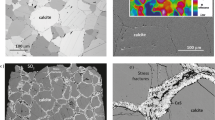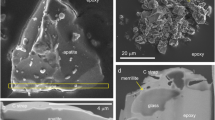Abstract
It has been suggested1,2 that acids in the cold polar ice sheets may exist as aqueous mixtures at grain boundaries. This assumption can correctly predict the d.c. conductivity of polar ice2, but this does not prove the existence of acids or liquid veins at grain boundaries, and this remains controversial3–5. In this study we used a scanning electron microscope (SEM), equipped with a cold stage and an energy-dispersive X-ray microanalysis facility, to determine the location of sulphur in ice from the Antarctic Peninsula. As expected, sulphur was undetectable in the bulk of the ice. However, at the junctions where three grains met (triple-junctions), sulphur was found in concentrations greater than 1 M in areas of < 1 μm2. Calculations show that between 40 and 100% of the sulphuric acid present in this ice was found at the triple-junctions, and would have been liquid at ice-sheet temperatures. This finding, if general, has considerable implications for many of the physical properties of polar ice.
This is a preview of subscription content, access via your institution
Access options
Subscribe to this journal
Receive 51 print issues and online access
$199.00 per year
only $3.90 per issue
Buy this article
- Purchase on Springer Link
- Instant access to full article PDF
Prices may be subject to local taxes which are calculated during checkout
Similar content being viewed by others
References
Maccagnan, M. & Duval, P. Ann. Glaciol. 3, 195–198 (1982).
Wolff, E. W. & Paren, J. G. J. geophys. Res. 89, 9433–9438 (1984).
Hammer, C. U. J. Phys., Paris, 48, C1, 651 (1987).
Legrand, M., Petit, J-R. & Korotkevich, Y. S. J. Phys., Paris 48, C1, 605–611 (1987).
Schwander, J., Neftel, A., Oeschger, H. & Stauffer, B. J. phys. Chem. 87, 4157–4160 (1983).
Mulvaney, R. & Peel, D. A. Ann. Glaciol. 10 (in the press).
Wyness, L. E., Morris, J. A., Oates, K., Staff, W. G. & Huddart, H. J. Path. 153, 61–69 (1987).
Russ, J. C. J. submicrosp. Cytol. 6, 55–79 (1974).
Brombach, J. D. J. Micro. Biol. cell. 22, 233–238 (1975).
Oates, K. & Potts, W. T. W. Micron. microsc. Acta 16, 1–4 (1985).
Nye, J. F. & Frank, F. C. Proc. Symp. on Hydrology of Glaciers IAHS Publ. 95, 157–161 (International Association of Hydrological Sciences, Gentbrugge, Belgium, 1973).
Lliboutry, L. J. Glaciol. 10, 15–29 (1971).
Paren, J. G. & Walker, J. C. F. Nature phys. Sci. 230, 77–79 (1971).
Davies, T. D., Vincent, C. E. & Brimblecombe, P. Nature 300, 161–163 (1982).
Author information
Authors and Affiliations
Rights and permissions
About this article
Cite this article
Mulvaney, R., Wolff, E. & Oates, K. Sulphuric acid at grain boundaries in Antarctic ice. Nature 331, 247–249 (1988). https://doi.org/10.1038/331247a0
Received:
Accepted:
Issue Date:
DOI: https://doi.org/10.1038/331247a0
This article is cited by
-
Jarosite formation in deep Antarctic ice provides a window into acidic, water-limited weathering on Mars
Nature Communications (2021)
-
Possible displacement of the climate signal in ancient ice by premelting and anomalous diffusion
Nature (2001)
-
Ancient atmosphere- Validity of ice records
Environmental Science and Pollution Research (1994)
Comments
By submitting a comment you agree to abide by our Terms and Community Guidelines. If you find something abusive or that does not comply with our terms or guidelines please flag it as inappropriate.



